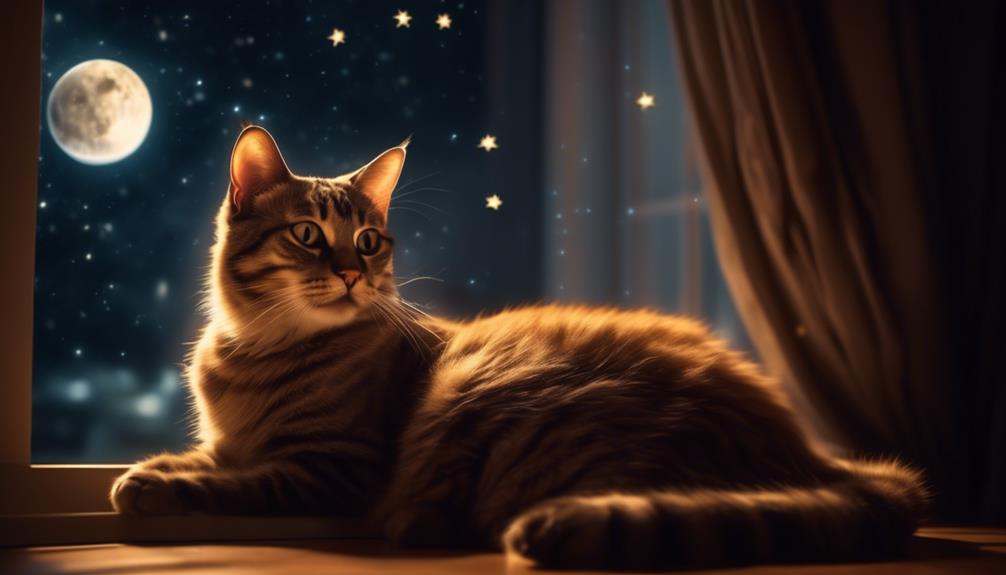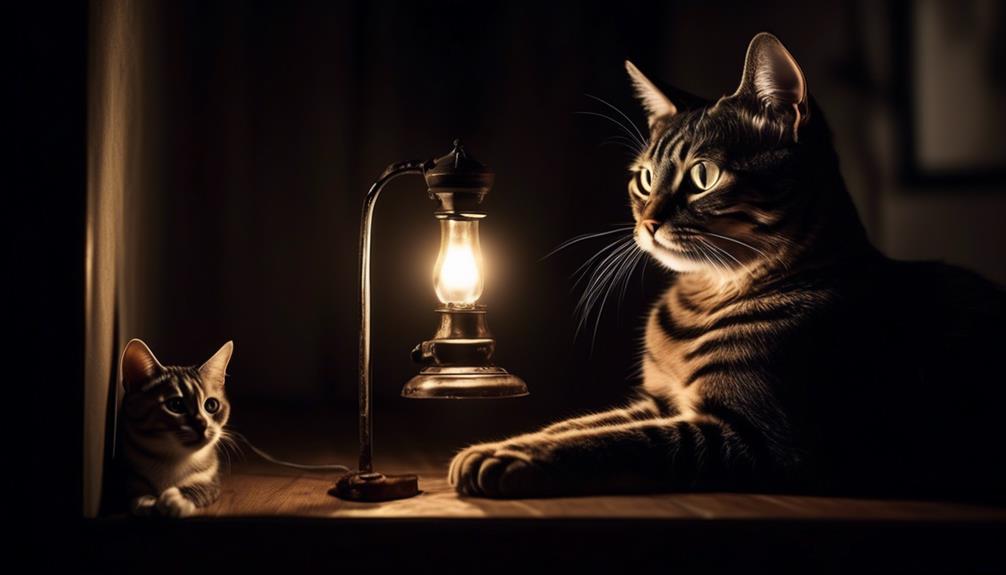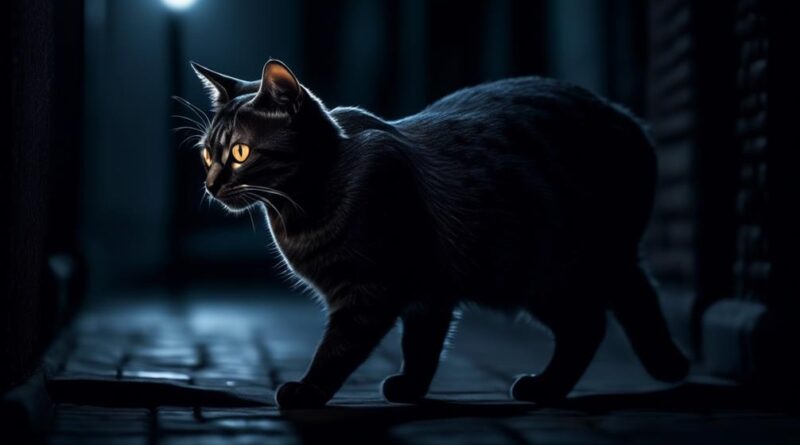Why Do Cats Act Differently at Night?
Have you ever noticed that your cat seems to transform into a different creature as soon as the sun sets?
The mysterious behavior of cats at night has puzzled pet owners for generations.
From their sudden bursts of energy to their penchant for knocking things off shelves, cats seem to have a whole other personality after dark.
But what causes this change in behavior? Is it purely instinctual, or are there other factors at play?
Let's explore the fascinating world of feline behavior after hours and uncover the reasons behind their enigmatic nighttime antics.
Nocturnal Instincts
If your cat seems more active and playful at night, it's because of their natural nocturnal instincts. Cats are crepuscular animals, meaning they're most active during the dawn and dusk. This behavior stems from their instinctual behaviors and biological adaptations to survive in the wild. In their natural habitat, cats are skilled predators, and their keen senses and agility make them excellent hunters during low-light conditions. This is why domestic cats still exhibit these behaviors, becoming more alert and energetic when the sun goes down.
Biological adaptations also play a significant role in your cat's nocturnal activities. Their eyes have a higher number of rod cells, which are sensitive to low light, allowing them to see more effectively in the dark. Additionally, their whiskers and highly developed senses of hearing and smell enable them to navigate and hunt in the darkness. These biological adaptations give them a distinct advantage during nighttime activities, making them more inclined to be active and playful during these hours.
Understanding these instinctual behaviors and biological adaptations can help you cater to your cat's needs. Providing interactive toys and engaging activities during the evening can help satisfy their natural instincts and prevent them from becoming bored or restless. Creating a stimulating environment during the night can also encourage them to exhibit their natural behaviors in a healthy and manageable way.
Sleep Patterns
At night, cats typically experience multiple short periods of deep sleep, interspersed with brief periods of wakefulness. This pattern is linked to their natural sleep cycles and feline behavior. Understanding these sleep patterns can provide insight into nighttime activity and cat psychology.
Cats are polyphasic sleepers, meaning they have multiple sleep cycles throughout a 24-hour period. This allows them to be active during both the day and night, as they don't experience one long continuous sleep like humans.
During their deep sleep phases, cats may exhibit twitching or other movements, indicating that they are in the rapid eye movement (REM) phase. This is when most dreams occur, suggesting that cats, like humans, may also dream during their sleep.
Cats' sleep patterns are influenced by their hunting instincts and survival mechanisms. In the wild, cats would need to be alert and ready to hunt at any time, so their ability to quickly transition between sleep and wakefulness is an evolutionary advantage.
Understanding the sleep patterns of cats can help cat owners provide an environment that promotes healthy sleep habits for their pets. Providing a comfortable and safe sleeping area, engaging in interactive play sessions during the day, and maintaining a consistent feeding schedule can all contribute to better sleep for cats.
Hunting Behavior
Cats' natural sleep cycles and hunting instincts directly influence their behavior at night, particularly their hunting behavior. Their predatory instincts and prey drive are at their peak during the nighttime hours. Cats are crepuscular hunters, meaning they're most active during the dawn and dusk hours. This behavior is linked to their wild ancestors who were also active during these times. When cats are awake at night, they exhibit territorial behavior, patrolling their environment and marking their territory with scent glands located on their cheeks and paws. This behavior is an expression of their hunting instincts, as they're constantly surveying their domain for potential prey.
Cats' hunting techniques are a combination of stealth, patience, and agility. Their keen senses, especially their exceptional night vision, allow them to detect even the slightest movement in the dark. Once they spot potential prey, they stalk it with precision, using their flexible bodies to move silently and remain undetected. When the time is right, they pounce with remarkable speed and accuracy. These hunting techniques are deeply ingrained in their nature and aren't simply a means of obtaining food, but also a way for them to express their natural instincts.
Understanding your cat's hunting behavior can help you provide them with appropriate outlets for their predatory instincts. Interactive toys and play sessions can simulate hunting activities, providing mental stimulation and physical exercise, which are essential for a cat's overall well-being.
Environmental Factors
To understand the behavior of cats at night, consider the impact of environmental factors on their nocturnal activities. Cats are crepuscular animals, meaning they're most active during twilight hours, dawn, and dusk. Environmental factors play a significant role in shaping their behavior during these hours.
- Lighting impact, natural instincts: Cats are natural hunters, and their nocturnal behavior is influenced by their instinctual need to hunt. The low light at night triggers their predatory instincts, making them more alert and active. The darkness provides them with a sense of stealth and security, allowing them to exhibit hunting behaviors such as stalking, pouncing, and chasing. This natural instinct has been ingrained in their DNA through generations of evolution, making them more prone to nocturnal activities when the lighting is favorable for hunting.
- Temperature influence, territorial behavior: Environmental factors like temperature can influence a cat's behavior at night. Cats are known to be territorial animals, and the cooler temperatures at night may prompt them to patrol and mark their territories more actively. The lower temperatures can also make them more energetic, leading to increased night-time exploration and territorial displays. Understanding the influence of temperature on a cat's territorial behavior sheds light on why they may act differently at night compared to during the day.
These environmental factors provide insight into the adaptive nature of cats and how they've evolved to thrive during the nighttime hours.
Circadian Rhythms

Circadian rhythms significantly impact cats' behavior at night, influencing their activity levels and biological patterns during the twilight hours. Cats, like humans, have a biological clock that regulates their sleep cycle and influences their behavior. This internal clock is synchronized with the natural light-dark cycle, guiding their instincts and activity patterns.
The biological clock, also known as the circadian rhythm, plays a crucial role in regulating a cat's sleep-wake cycle. This cycle is influenced by the production of melatonin, a hormone that promotes sleep, and the suppression of cortisol, a hormone associated with wakefulness. As the sun sets and darkness falls, a cat's biological clock signals the release of melatonin, preparing them for sleep and influencing their behavior to become more relaxed and subdued.
In addition to the biological clock, a cat's natural instincts and behavior patterns are also influenced by circadian rhythms. Cats are crepuscular animals, meaning they're most active during the dawn and dusk hours. This behavior is deeply ingrained in their biology and can be traced back to their wild ancestors. During these twilight hours, a cat's heightened senses and predatory instincts are at their peak, making them more alert and active.
Understanding the impact of circadian rhythms on a cat's behavior at night can help pet owners create a conducive environment for their feline companions during these twilight hours. Providing opportunities for play and mental stimulation during these active periods can help satisfy their natural instincts and promote better behavior during the night.
Communication at Night
At night, you may notice that your cat communicates using a variety of vocalizations and body language to convey their needs and emotions. Cats have distinct nighttime vocalizations that serve various purposes. From loud meowing to purring, each vocalization has a specific meaning.
Pay attention to your cat's body language as well. They may use subtle cues to convey their feelings, such as:
- Tail position: A cat's tail can indicate its mood. A twitching or thrashing tail may signal agitation, while a raised tail with a slight curve at the tip often signifies a content and confident cat.
- Ear movements: Cats' ears are highly expressive. Forward-facing ears indicate interest or alertness, while flattened ears may signal fear or aggression.
- Purring: While commonly associated with contentment, cats also purr when they're in pain or distress. Understanding the context and accompanying body language is crucial in interpreting this vocalization.
Human Interaction

As you observe your cat's nighttime communication behaviors, you can also notice how they interact with you during the night, displaying their preferences for human interaction. Cats are known for their independent nature, but at night, they often seek attention and display playful behavior. You might find your cat pawing at you, nudging you, or even bringing you toys as a way to initiate play and interaction. This is because cats are crepuscular animals, meaning they're most active during dawn and dusk, which translates to heightened activity levels and a desire for interaction during the nighttime hours.
During the night, your cat's attention-seeking behavior might become more pronounced. They may follow you around the house, vocalize more frequently, or even try to curl up on your bed. This behavior indicates that they're seeking companionship and interaction with you. It's important to acknowledge and engage with your cat during these times, as it can strengthen your bond and provide mental stimulation for your feline friend.
Understanding and responding to your cat's playful behavior and attention-seeking tendencies at night is crucial for maintaining a harmonious relationship. Taking the time to play with your cat before bedtime and providing interactive toys can help satisfy their need for stimulation and prevent disruptive behavior during the night.
Remember that your cat's nighttime interactions are a way of expressing their needs and desires, and responding to them with patience and understanding can lead to a more peaceful coexistence during the nocturnal hours.
Addressing Nighttime Behavior
To address your cat's nighttime behavior, consider establishing a consistent evening routine to help your feline companion transition into a calmer state before bedtime. This routine could include interactive playtime, followed by a small meal to mimic the natural pattern of hunting and eating in the wild. After this, engage in quiet activities such as grooming or petting to help your cat wind down for the night.
Addressing Nighttime Behavior
- Feline Behavior: Understanding your cat's natural instincts and behaviors can help you create a nighttime routine that addresses their needs and promotes a sense of security and comfort.
- Environment Enrichment: Providing mental and physical stimulation during the day can help reduce nighttime restlessness and encourage a more peaceful night's sleep for your cat.
- Consistency and Patience: It's important to be patient and consistent when implementing changes to your cat's nighttime habits. It may take time for your cat to adjust to a new routine, so consistency and patience are key.
Frequently Asked Questions
Can Cats See Better in the Dark Than Humans?
Yes, cats can see better in the dark than humans. Their night vision capabilities are due to a special layer in their eyes that reflects light. This allows them to see in low light conditions.
Because of this, cats are more active at night, which is part of their natural feline behavior. In contrast, human eye sensitivity to low light isn't as strong, so we tend to engage in fewer nocturnal activities.
Do Cats Need to Be Kept Indoors at Night for Their Safety?
At night, it's best to keep your cat indoors to protect them from outdoor dangers. Cats are more active at night, and their nighttime habits can pose risks outside. By keeping them inside, you ensure their safety and prevent potential harm.
Creating a comfortable indoor environment with toys and activities can help satisfy their nighttime instincts, keeping them safe and content.
Are There Specific Breeds of Cats That Are More Active at Night?
Some cat breeds are more active at night due to their genetics. Nighttime behavior in cats can be influenced by their nocturnal tendencies and environmental factors.
Certain breeds, such as Siamese and Abyssinian, are known for being more active during the night. Their genetic makeup and historical roles as hunters contribute to their increased activity levels in the evening.
Understanding your cat's breed and inherent traits can help you better accommodate their nighttime behavior.
How Can I Prevent My Cat From Waking Me up at Night?
To prevent your cat from waking you up at night, try training methods like providing interactive toys or food puzzles before bedtime to tire them out.
Engage in nighttime activities to encourage a consistent sleep schedule.
Make environmental changes by ensuring the room is quiet and dark.
Understand your cat's behavior and provide a comfortable sleeping area.
These adjustments can help prevent disruptions and promote better sleep for both you and your cat.
Do Cats Have a Natural Sleep Cycle, or Do They Adjust to Their Owner's Schedule?
Cats have a natural sleep cycle based on their circadian rhythm and nocturnal behavior. They're instinctively more active at night, regardless of their owner's schedule. While they may adjust slightly to the owner's routine, their nocturnal instincts often prevail.
This can lead to them acting differently at night, regardless of your schedule. It's important to understand and accommodate their natural sleep patterns to prevent disruptions at night.
Conclusion
So next time you wonder why your cat acts differently at night, remember it's just their natural instincts at play.
While it may be frustrating at times, understanding their nocturnal behavior can help you find ways to accommodate their needs while also getting a good night's sleep yourself.
Whether it's providing stimulating toys, adjusting their feeding schedule, or simply giving them some extra love and attention, there are ways to address and manage your cat's nighttime behavior.
